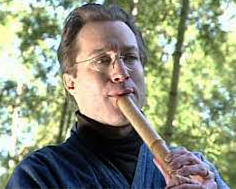
Bruce Huebner
Journey Back to America
Bruce Huebner went to Japan in 1998 as a Monbusho Ministry of Education scholar, where he entered the Japanese Music Department of the Tokyo University of the Fine Arts and Music (Geidei). There he studied under the Living National Treasure, Yamaguchi Goro for nearly five years, becoming the first non-Japanese to graduate from the prestigious Geidai. After moving to the Tohhoku Region of Northern Japan in 1994, he produced solo shakuhachi recitals with guests Kawase Junsuke in 1995 and Murooka Shoko (Yamada School Koto) in 1996. He earned his Shihan mastership in 1995 from Chikyusha. A scholar, university lecturer, and recording artist, Bruce is also the founder of the Contemporary Sankyoku Ensemble and author of a four-volume teaching video in English for shakuhachi.
The photos below are taken from a documentary film, aired on Japanese television, about Bruce Huebner's extraordinary life and work as a foreigner living in Japan, teaching the Japanese about their own traditional music and culture.
In the summer of 1998, Bruce paid a visit to Monty Levenson, his wife Kayo, and their daughters Eda and Anna at their rural homestead located 10 miles outside of the small town of Wiilits, California. While in the workshop, Bruce showed Monty two of his main instruments that had some performance issues, both of which Monty analyzed and fixed.This visit marks the beginning of a decades-long collaboration and friendship between Bruce and Monty based on their shared passion for shakuhachi and its musical tradition.
Fast forward 23 years to learn more about Bruce Heubner and his remarkable work with shakuhachi.























